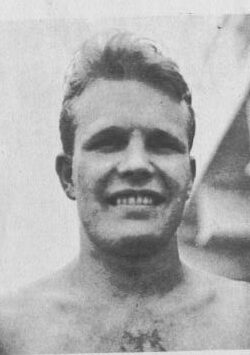
Miller Anderson (USA)
Honor Diver (1967)
FOR THE RECORD: OLYMPIC GAMES: 1948 silver (springboard); 1952 silver (springboard); NCAA CHAMPIONSHIPS: 5; NAAU CHAMPIONSHIPS: 7 indoor, 1 outdoor; WESTERN CONFERENCE CHAMPIONSHIPS: 3; originated the forward 1½ somersault with two twists and the backward 1½ with one twist.
The stopwatch, championship performance, Olympic honors, world and national records — these provide the accurate measured accomplishments which make it possible for objective selection of Swimming Hall of Fame honorees as in no other sport, but there is more. Among the super champions of our sport, occasionally we find unique characteristics of courage and desire under the most adverse circumstances. Such perseverance against odds and resulting accomplishment in spite of handicap may set some rare individual a cut above his fellow champions. Such a special leadership and inspiration was displayed throughout his war injury interrupted career by the late Miller Anderson, honor diver.
Anderson won his first AAU championship gold medal at New Haven, Connecticut in the Spring of 1942, during the time that he was enrolled as a freshman at Ohio State. Subsequently, he enlisted in the Army Air Corps and was commissioned as a pilot the following year. For Air Campaigns in the Balkans, Southern France, Po Valley, Apennines and Rome-Arno, Anderson was awarded five battle stars, the Distinguished Flying Cross, Purple Heart, Air Medal with six Oak Leaf Clusters, and the Silver Star. Flying a P-47 dive bomber in his 112th mission over Italy, flak from German anti-aircraft guns riddled his plane and he was forced to bail out. In doing so, his left leg was nearly torn off by the plane’s tail and upon landing, he was captured by the Germans and hospitalized. About a month later, the hospital in which he was bedridden was captured by U.S. forces and Anderson was flown to Rome to undergo an operation by U.S. Army surgeons, narrowly missing amputation. Silver plates were screwed to the thigh bone above his left knee and it was considered certain that he would never dive again. Recuperation was a year long process and Anderson was determined. When he resumed diving workouts, he had to learn to “take off” with pressure from his right leg (which was not normal for him).
Returning to competition in 1946, he began one of the most remarkable comebacks in sports history. Including his first AAU gold medal as a freshman, Anderson went on to win a total of 16 major titles, 3 Western Conferences, 5 NCAAs, 7 NAAUs indoor and 1 AAU outdoor. In 1947, his senior year and as Ohio State varsity captain, Anderson was voted “outstanding swimmer in intercollegiate competition” by the selection committee of the College Swimming Coaches Association of America. He also represented his county at the London Olympic Games in 1948 and again in Helsinki in 1952, adding 3 meter springboard Olympic silver medals in each instance.
“For sheer courage, spirit, desire, determination, natural ability and sportsmanship, I believe Miller Anderson is the greatest,” remarked Ohio State’s Hall of Fame coach Mike Peppe, when asked to rate his many champion divers. Noted for his remarkable ability as a “twist” diver, Anderson originated the forward 1 1/2 somersault with two twists and the backward 1 1/2 with one twist and introduced these two dives into competition.
In 1966 at age 42, Miller Anderson suffered a fatal heart attack in his home in Columbus, Ohio.
